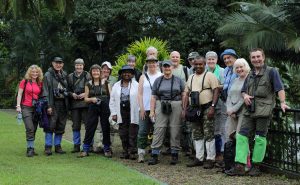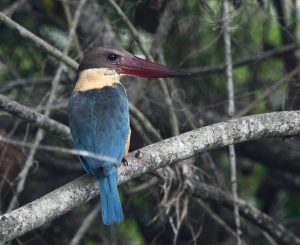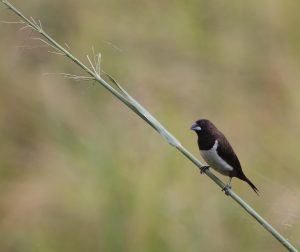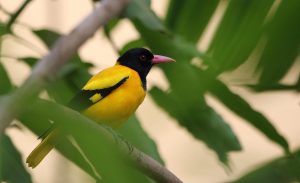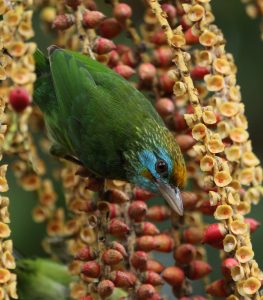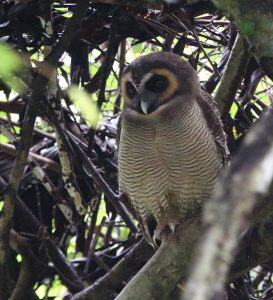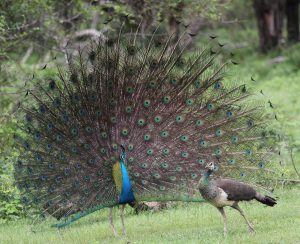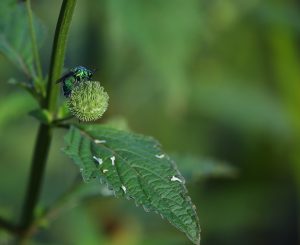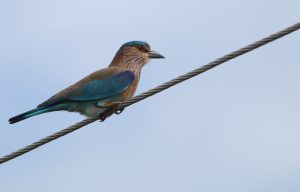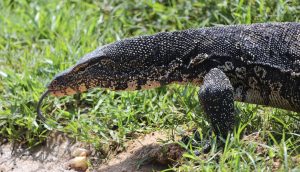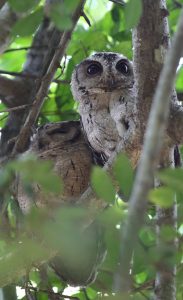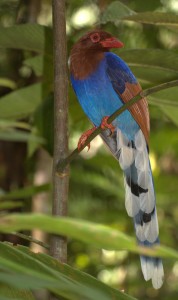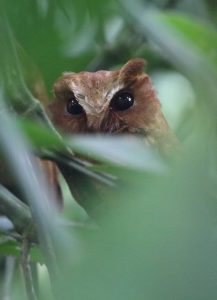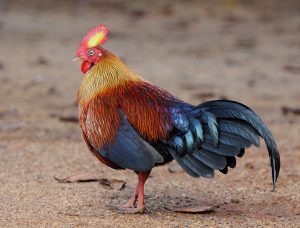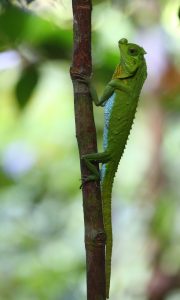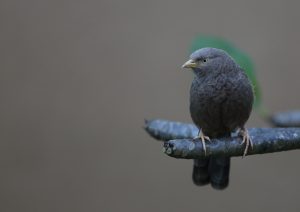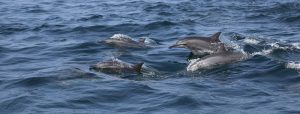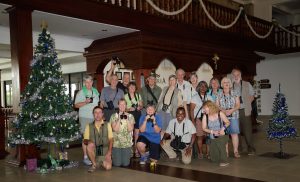Leaving Britain at a chilly 3°C for Sri Lanka at a lovely warm 27°C seems like a good move, especially considering the birds to be seen here, starting with ubiquitous House Crows on the car park outside Columbo International Airport, followed by Asian Open-billed Stork, Indian Pond Heron, Common Myna and plenty of Cattle Egrets in the paddyfields, as our driver slowly negotiates a course between all the dogs, mopeds and three-wheeled Tuk-tuks, while papping constantly. A very civilized roadside stop for afternoon tea and cake produces Spotted Dove, White-throated Kingfisher and Yellow-billed Babbler with ease, while a later leg-stretching stop alongside the Kelani River reveals Little Cormorant, Blue-tailed Bee-eater, White-bellied Drongo, two more White-throated Kingfishers and the Black-rumped Flameback, a woodpecker with a stunning scarlet back. Journey’s end is the Kitulgala Resthouse in a super setting overlooking the film set for Bridge on the River Kwai, where ‘Stonking’-billed Kingfisher is added to an enviable list, and we haven’t really started yet!
We start the new day before dawn with a nice cup of tea and then stroll a short way from the lodge as birds like Brown-capped Pygmy Woodpecker, Sri Lanka Swallow, Oriental Magpie Robin, Red-vented Bulbul, Common Tailorbird and the endemic Yellow-fronted Barbet begin to stir right outside the lodge, with Asian Palm Swifts, Indian Swiftlets and Crested Treeswifts wizzing to and fro above the tree tops. It’s soon pouring with rain and not conducive to an appearance by our target Chesnut-backed Owlet, so we head back to base for breakfast, which is eventually scrambled for an Asian Koel and Sri Lanka Grey Hornbills right outside the dining room verandah. Setting off again a small wobbly raft paddled by one man ferries us across the river, with White-rumped Munias showing well on the other side. Wandering through the village we find Greater Coucal, Black Bulbul, Loten’s and Purple-rumped Sunbirds, Small Minivet, Black-hooded Oriole and more Yellow-billed Babblers alongside the more rusty-looking, endemic Orange-billed Babbler. Further on a bare-topped tree provides perches for Imperial Green and Sri Lanka (Pompadour) Green Pigeons and a Giant Squirrel, while an Oriental Honey-buzzard sits obligingly on a low tree top for an intimate view in the scope. A suspension bridge across the river puts a spring in our step on our way back to the lodge for another ‘cuppa’. Not a bad list for a wet morning.
By 2pm the rain has eased off so we restart with a noisy group of endemic Layard’s Parakeets with smart blue-grey heads, backs and tails, and a red or black bill, according to their gender. A short drive takes us to a wooded area close to Kitulgala Police Station, where early sightings include Ceylon Birdwing, the island’s largest butterfly, with a wingspan wider than those of many birds, plus close views of more White-rumped Munias and a male Purple-rumped Sunbird with a dazzling iridescent green cap, followed by Asian Brown Flycatcher. After a quiet half hour, our brilliant guide Dhammi hears the endemic Chestnut-backed Owlet calling nearby, which we eventually locate and pinpoint in the scope thanks to the mobbing behavior of various smaller birds. The next hour is very productive with plum scope views of a supporting cast, including, in order of appearance, the endemic Spot-winged Thrush, Emerald Dove, Chestnut-headed Bee-eater, a steely male Sri Lanka Grey Hornbill, with ruby red eyes and an ivory bill, Sri Lanka Hanging Parrot, Lesser Yellownape, another stunning woodpecker, Bar-winged Flycatcher-shrike, Asian Paradise-flycatcher and Black-hooded Oriole, and all from virtually the same spot, while at least four of these bright yellow male Orioles put on a great show while chasing each other around the nearby tree tops. Strolling back to the waiting coach Oriental White-eyes, dangling from a tree overhanging the path, round off a really good afternoon, with sightings of eight endemics after just one full day here. What a great way to spend a birthday.
There is a feeding frenzy in a flowering tree outside the dining room this morning, which is full of Oriental White-eyes as well as Red-vented Bulbul, Jerdon’s and Golden-fronted Leafbirds, and both Pale-billed and endemic Legge’s Flowerpeckers, doing exactly what it says on the tin. Meanwhile, a hanging inflorescence of ripe red fruits is visited by an Asian Koel, a Sri Lanka Grey Hornbill and a trio of Yellow-fronted Barbets. After breakfast we leave this lush jungle setting and head off on the upward winding road through a verdant landscape of tea plantations, where the neatly clipped tea bushes follow the hillside contours in tidy rows. The Saint Clair Tea Castle is the ideal place for a mid-morning tea break, as well as a photo shoot of the nearby waterfall alongside posing Toque Macaques. Back on the road, we stop again for a large and noisy daytime roost of Fruit Bats with shining black wings and gorgeous golden fur coats. After lunch at the sumptuous Hill Club in Nuwara Eliya, we go for a walk in nearby Victoria Park. With its neat flowerbeds, manicured lawns, pouring rain, House Sparrows and Grey Wagtails it feels like home, but then marvellous views of the multicoloured Indian Pitta and handsome Forest Wagtail remind us of our exotic location.
Setting off before dawn in a monsoon seems like a nutty idea but this is birding. It is barely light by the time we arrive at the entry gate to Horton Plains National Park, but the weather is appalling with driving rain and low cloud. With non-stop rain here for the last three days, the sodden Sri Lanka Whistling Thrush has nothing to whistle about and so there is no hope of seeing this endemic rarity. After breakfast in the ‘café’, a covered viewpoint provides shelter for spotting a bedraggled Paddyfield Pipit and a pair of Pied Bushchats, while a very friendly rain-soaked Sambar Deer stag approaches to within stroking distance! In view of the washout conditions we decide to throw in the towel, and head back to the comfort of our hotel, spotting a group of Sri Lanka Junglefowl sheltering in the lee of some bushes on the way. After lunch, a slide show reveals what we might have seen given better weather, and in almost twenty years of leading trips I have rarely had such a bad weather day! That’s another memorable birthday for another member of the group, and another cake to eat!
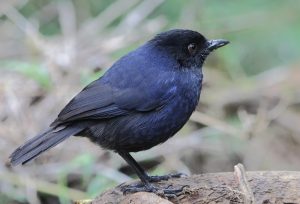
It’s a new day, with the same old rain, but we are determined to revisit the park, where the ornamental pond is now overflowing, sending a torrent of water gushing along the main path and out through the park gates, while the lawn has become a wetland, with several pools attracting numerous Indian Pond Herons, and there is even a Little Cormorant swimming in a small fountain pool! We soon find Sri Lanka White-eyes busy feeding in the specimen trees, and eventually locate the endemic and exotic-looking Yellow-eared Bulbul, a pair of wintering Kashmir Flycatchers and a female Indian Blue Robin skulking in the undergrowth and looking remarkably like ‘our’ Nightingale. After breakfast back at ‘the club’, we head south where a roadside stop produces good views of the endemic Dull Blue Flycatcher and Yellow-eared Bulbul, while the calling Sri Lanka Whistling Thrush remains hidden. A little further along the road, a cultural stop at the ornately sculpted Sriramajayam Hindu temple also adds Grey-headed Canary-flycatcher to the list. By late morning it has actually stopped raining and there is a strange bright light up in the sky! As soon as we arrive at the Surrey Estate Bird Sanctuary, we are scoping a fantastic female Greater Flameback (aka Crimson-backed Goldenback) a large woodpecker with an ivory bill and a white-spotted black cap. A couple of endemic Brown-capped Babblers pass through the undergrowth near the entrance, and deeper into this small patch of forest, a mixed feeding flock passes right by us allowing close views of gems like Sri Lanka Scimitar-babbler, Velvet-fronted Nuthatch, Scarlet Minivet, Brown-headed Barbet and Grey-headed Canary-flycatcher, although the star of the show here is a magnificent Brown Wood Owl, starring at us with a pair of large jet black eyes. By mid afternoon it is raining again and the steeply sloping roadsides are awash with small waterfalls and scarred by numerous fresh landslips. Eventually we reach a new landscape of flooded paddyfields, jam-packed with Cattle Egrets and the occasional Woolly-necked Stork, as well as a Brahminy Kite and a couple of spectacular Malabar Pied Hornbills. Not a bad list for a travelling day.
It’s 1st December and still raining as we set off for nearby Yala National Park, but by the time we arrive at around 6.15am the rain has thankfully eased off at last. We soon get close views of Wild Boar on the track ahead, followed by the first of many Spotted Deer, plus Barn Swallows, Indian Robins, Green Bee-eaters and Indian Peafowl galore. Eventually we have to refrain from stopping and photographing the many Green Bee-eaters perching on conveniently low twigs right beside the tracks, and soon the Peacocks barely get a second glance, although we make an exception when the majestic males perform their impressive fanned-tail displays, complete with a shaking sound as they quiver their fans to impress the hens. The park teems with wildlife and notable early sightings include a small group of Cotton Pygmy-geese, a tree full of Crested Treeswifts, Yellow-wattled and Red-wattled Lapwings side by side, alongside the jeeps, as well as a Green Imperial Pigeon in the same fruiting bush as a Malabar Pied Hornbill, delicately throwing back tiny black fruits with its enormous hefty bill. New sightings come thick and fast this morning such as Lesser Whistling-duck, Painted Stork, Intermediate and Great Egrets, Eurasian Spoonbill, Oriental Darter, Changeable Hawk-eagle, Pheasant-tailed Jacana, Pacific Golden Plover, Lesser Sand-plover, Marsh and Wood Sandpipers, Whiskered Tern, Orange-breasted Green Pigeon, Jacobin Cuckoo, Jerdon’s Bushlark, Ashy-crowned Sparrow-lark, White-browed Bulbul, White-browed Fantail, Indian Silverbill and Scaly-breasted Munia. On top of all these new birds for the trip, we also enjoy seeing a Ruddy Mongoose right beside the jeeps, plus Marsh Mugger Crocodiles, large Land Monitor Lizards, Grey Langur Monkeys, three Asian Elephants and plenty of Water Buffalo and Black-naped Hares, at very close range, and unfazed by the vehicles. After a picnic lunch by a very scenic beach, with a tiny Grey-breasted Prinia showing well while singing in the scrub, as a White-bellied Sea Eagle soars back and forth, we continue finding new birds this afternoon, such as a pair of Marshall’s Ioras, Ashy Drongo, the endemic Black-capped Bulbul, Brahminy Starling and Black-headed Munia. With an abundance of prey in an ideal rocky wooded habitat, Yala is famous for its high density of Leopards, but despite rumours of a nearby sighting and almost ten hours in the jeeps searching, there is no sign of this elusive big cat.
Hooray! The unseasonal cyclone seems to have moved on at last, and so we have some blue sky for our visit to the ‘Tissa tanks’, where we soon have Yellow Bittern and Purple Gallinule in the top of the same little bush surrounded by water, well vegetated with lily pads and rushes, and teeming with birds such as Purple Heron, Indian Pond Heron, Intermediate Egret, Spot-billed Pelican, Oriental Darter, Pheasant-tailed Jacana, noisy Rose-ringed Parakeets, Whiskered and White-winged Terns, White-throated and Stork-billed Kingfishers, Blue-tailed Bee-eater, Plain Prinia, Black-headed Munia, a juvenile Watercock, looking just like a Corncrake, and a Black Bittern with a beautiful pattern of intricate rufous markings on its sinuous neck. Meanwhile, Dhammi gets a ‘call’ from a Jungle Owlet in a nearby back garden, and we soon have this neat little poser pinpointed in the scope. Within twenty minutes, our local scouts call again and this time it’s the much larger Brown Fish Owl, which is soon starring into the scope with large yellow eyes, while ignoring a group of mobbing Yellow-billed Babblers. Back in the wetlands, the variety and colour of the butterflies and dragonflies is amazing, sending the cameras into overdrive, and there is even a bee which glistens like emeralds and sapphires; incredible. On the way back to the hotel for some r & r by the pool and then lunch, we visit a Buddhist temple with a nesting colony of Black-crowned Night Herons and Indian Cormorants, and an ice cream van!
This afternoon we visit Bundala National Park, where the welcoming party is a troop of bounding Grey Langur Monkeys, followed by Indian Roller on a trackside wire and Grey-headed Fish Eagle on top of a bush. Our next new bird is Pied Kingfisher, while a large Soft-shelled Terrapin shows well at the side of the track, presumably having recently laid her eggs in the soft sandy ground. This large coastal wetland is choc-full of water birds, including six different Terns; Little, Whiskered, Gull-billed, Lesser Crested, Greater Crested, and the mighty Caspian, as well as twenty different waders! Amongst this ‘wader fest’ are Little Stint, Pacific Golden, Grey and Kentish Plovers, Lesser Sand-plover, Black-winged Stilt, Marsh, Broad-billed and Curlew Sandpipers, Whimbrel, and Great Thick-knees with enormous crab-crunching bills. At one point we even have a Curlew in the same scope view as an Elephant! Now that’s definitely something you don’t see every day. On top of all this we also scope a really cute little Small Pratincole and a White-bellied Sea Eagle, on the ground while tearing into its prey.
We have an early start this morning for a jeep safari in Udawalawa National Park, where there is a whacky race from the first barrier for the ticket booth, between rival jeeps at 6am sharp. After the initial mayhem, we are soon into relaxed birding mode with three Prinias at close range; Jungle, Plain and Ashy, as well as another Marshall’s Iora, soon followed by Yellow-eyed Babbler, and by 6.50am we have a close encounter with our first Elephants of the day, a young calf staying close to its mother. During the morning, several Changeable Hawk-eagles show well, while new birds include Crested Serpent-eagle, Black-winged Kite, Sirkeer Malkoha, Hoopoe, Blyth’s Reed Warbler and a posing Zitting Cisticola. One of the fords is very productive with a statuesque Painted Stork making a nice reflection right next to the track, alongside a couple of noisy Red-wattled Lapwings, Common and Wood Sandpipers, and an amorous Marsh Sandpiper insistently chasing a potential partner round in feverish circles, and occasionally trying to mount her from the wrong direction, providing plenty of footage for the cameras. Next we’re watching a group of five Elephants having a quiet rest less than ten yards from the track, before a late picnic breakfast alongside a lake with crowds of Painted Storks on the opposite side, and lots of Brahminy Kites circling above. On the way back, we stop for a White-bellied Sea Eagle at its bulky nest in a tree top right next to the track, and for an awesome six foot long monster Water Monitor, constantly flicking a six inch forked tongue as it lumbers along the edge of the track. This has to be the biggest lizard I have ever seen! By now the warm air has whipped up clouds of butterflies, creating an amazing sight.
After lunch and a group photo around the Christmas tree in the hotel foyer, Dhammi shows us a pair of Collared Scops Owls roosting in a tree above the car park, before we set off for Sinharaja, with Brown Mongoose and a five foot Rat Snake crossing the road ahead along the way. It starts to rain again just as we arrive at our lodge in the rainforest near Sinharaja, with thunder rumbling ominously in the distance. After dark, there is a deafening chorus of raucous frogs and chirping insects to accompany the conversation over dinner in the open air dining area.
We have a lie in this morning with breakfast at six! A battered old Jeep which drives like a tank, with no front doors or windscreen wipers, and a tangle of wires hanging below the dashboard, where few of the dials work, takes us at a slow walking pace along the bumpiest of tracks up to the Sinharaja Forest Reserve, but before we get to the main gate, our newly recruited local guide called Thandula, with whom I worked in 2014, leads us along a narrow path for lovely views of White-faced Starling and Sri Lanka Blue Magpie, a vivid confection of chestnut, red, white and royal blue, and so that’s two new endemics for the trip in just five minutes! Once inside the forest reserve, we find Orange-billed Babblers again, and then a giant eight inch millipede, a foot long bright green Hump-nosed Lizard, a Giant Wood Spider, with an enormous web housing five miniscule attendant males, and a Dark-fronted Babbler building an untidy leafy nest. I don’t know how they do it but the local guides find a pair of well-hidden Sri Lanka Frogmouths, one grey, one rufous, snuggled together for the day on a branch off the main track, just a few feet away from us after a short deviation into the dense foliage. This strange nocturnal relative of Nightjars is not actually endemic to Sri Lanka, as it also occurs in a small area of southern India. At the far end of the trail, we also find the Sri Lanka Drongo, with a long deeply forked tail, and the endemic Red-faced Malkoha, a large, long-tailed member of the Cuckoo family. On the way back along the trail, we marvel at the delicate graceful flight of the large black and white Tree Nymph butterflies, while new birds include Brown-breasted Flycatcher, a pair of Malabar Trogons and a raucous mob of fifteen to twenty endemic Ashy-headed Laughingthrushes roving through the leaf litter and oblivious to our presence.
After lunch back at the lodge, with a visit from a white male Asian Paradise-flycatcher, we pile back into the Jeeps to rendezvous with another of Dhammi’s contacts, who knows the location of one of Sri Lanka’s rarest and most mythical birds, the recently discovered Serendib Scops Owl. After another bumpy Jeep ride, followed by a scramble down a muddy slope and a short creep through the dense shrubbery, taken in turns, there they are, little more than five yards away, not one but two of these small ginger owls, starring at us, eyes wide open. This amazing find is compounded by the presence of another Frogmouth, barely ten yards away from the owls! By the time we have all seen all three birds, it is quite dim and the rain returns, continuing well into the night, to the delight of all the peeping and croaking frogs.
We start the new day with tea and biscuits at 4.30am before setting off to a nearby house, where the full moon is still shining brightly, as we arrive, with the eerie howls of Frogmouths ringing out from the jungle nearby. The plan is to stake out the backyard from the open kitchen door and window, where a variety of birds habitually visit each morning to search for rice which the owner generously scatters. By 6am a Spot-winged Thrush is calmly feeding within three feet of the house, swiftly followed by a band of Ashy-headed Laughingthrushes, Orange-billed Babblers, a handsome male Emerald Dove, and even a beautifully marked Slaty-legged Crake. A spotted Mouse Deer saunters by and a cock Sri Lanka Junglefowl is next to arrive, with his harem of hens and a scruffy young male, all pecking and scratching at the ground just a few feet away from us, just like domestic chickens. Mr and Mrs Sri Lanka Spurfowl are latecomers to the garden party, arriving at around 7am, and by quarter past, the action is virtually over. With close views of five endemics, this is backyard birding par excellence, but there is more to see from the front garden, including Scarlet Minivet, Sri Lanka Blue Magpie and the shy Green-billed Coucal, another endemic! Back at the lodge, we have a late breakfast along with Black-capped, Yellow-browed and Black Bulbuls.
Returning to the entrance of the Sinharaja Forest Reserve, a couple of Keelback Water Snakes basking on lily pads provide a nice photo-opportunity, while a group of Sri Lanka Blue Magpies proves more of a challenge. At the start of the trail we find Scarlet Minivet, Asian Paradise-flycatcher, Black-naped Monarch and Large-billed Leaf Warbler, while sightings further into the forest include a Kangaroo Lizard at the side of the path, a Purple-faced Leaf Monkey with a bushy moustache, another Giant Millipede, a sizeable Green Pit Viper hanging around in a tree, and the huge Ceylon Rose Butterfly, while the Hump-nosed Lizard is in exactly the same location and pose as yesterday! Meanwhile, the bird activity is strangely quiet with female Malabar Trogon and male Asian Paradise-flycatcher, trailing a long flowing white tail, as the most notable sightings, but at least it hasn’t rained today!
A calling Chestnut-backed Owlet taunts us first thing this morning while playing hide and seek in the back of a large tree. We eventually pinpoint it, while also enjoying views of another male Asian Paradise-flycatcher, more dazzling Scarlet Minivets, and a Crested Goshawk sitting majestically in the top of a dead tree. After breakfast back at the lovely Birds Paradise Hotel, the friendly staff line up to bid us a safe journey and wave us off. A brief stop overlooking small paddyfields produces three different Munias, including Black-throated, which is new for the trip. The journey is delayed by a road traffic accident, but once on the newly constructed motorway, with large yellow signs saying “Danger Peacocks Ahead”, we arrive at our final base near Mirissa, on the south coast, in time for a late lunch and a chance to photograph the ‘garden birds’, like Loten’s Sunbird, Indian Robin, Asian Koel, White-bellied Drongo, Yellow-billed Babbler, Common Tailorbird, Common Myna and Scaly-breasted Munia, or to simply relax on the beach or by the pool, and reflect on how lucky we are to be here.
A white knuckle ride in a Tuk-tuk, driven by an aspiring racing driver, as he swerves within inches of sprawling dogs, pedestrians and on-coming traffic on the narrow winding approach to the harbour, is an exhilarating bonus before boarding the whale watching boat. Less than an hour from departure, we have a forty foot long Bryde’s Whale, with a characteristic markedly back-curved dorsal fin, spouting alongside the boat. Ten minutes later we have our first Blue Whales, a trio of these impressive eighty foot giants, spouting thirty feet into the air and then diving with a wave of their tail flukes as they submerge for between ten and twenty minutes. An hour or so flashes by as several blues repeatedly emerge in seemingly random directions. Each time a whale surfaces, we see the spouting blow hole and then a long sleek blue-grey arching back with a tiny dorsal fin, followed by one of two options; either the whale disappears without waving goodbye, evoking a collective sigh from all on board, or a collective gasp and a cheer if the whale submerges with water cascading off its wide flat tail fluke, pointing skyward before a deep dive. What a fantastic and memorable spectacle.
It’s not every day one gets to see Blue Whales, but today we have another ‘bite at the cherry’, and ten miles out, after an hour at sea, with amazing Flying Fish, skittering for over 100 yards in front of the boat, the whales are here again, showing their long arching backs, and often exposing Remora sucker fish passengers, as the spotter manically shouts “Cameras ready. Tail up, tail up”, followed by a barrage of camera clicks, an elated cheer and an anxious anticipation of where the next whale might emerge. After several such sightings, the crew suggests that we move on in search of dolphins, and so the boat homes in on a distant group of tiny fishing boats. As we get closer, the water around the boats appears to be boiling, caused by a ‘super pod’ of around two hundred Spinner Dolphins, energetically surfing and occasionally leaping clear of the water with an acrobatic roll; a spectacular show. More excitement follows on the way back to port, as we stumble upon a pair of mating Green Turtles, floating and rolling awkwardly, with flailing flippers, and then a massive black and white Manta Ray cruises past the boat just below the surface; wow!
My lovely group, and excellent local guide, all helped to make this a most enjoyable tour, with lots of wonderful experiences, and great sightings of a fabulous variety of exotic butterflies, reptiles, mammals and birds, including most of the endemic species.

